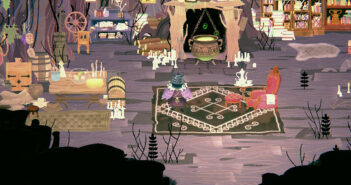In 2006, Roget Ebert, the film critic of the Chicago Sun-Times, wrote that video games can never be art. And before he could capture the words and stuff them back into his mouth, it was too late. He was bombarded by a deluge of messages claiming that if he’d only play this one game he’d change his mind (which would all add up to a lot of games that, I’m sure, are the “one”).
And in a somewhat direct response in 2007, author Clive Barker reacted to Ebert’s claim. I’m not going to rehash the tit-for-tat, but it’s available on Ebert’s Web site. Never fear: it’s fair.
Fast-forward to 2009 when video-game designer Kellee Santiago gave a talk where she defended video games as art, both in the now and in years to come. Foolish or not, she based her entire discussion off of Ebert’s original statement; watch the video here.
This talk was brought to the film critic’s attention. He responded, which is available for everyone to read. But be warned that I’ve been trying for days to load the page, and I have a speedy internet connection. Only recently was I successful. I’m sure the nearly 4,000 article comments don’t have anything to do with it.
In response to this essay proclaiming that video games can never be art, Jim Sterling of Games Radar US wrote a response that is needlessly mean-spirited and doesn’t help the argument that Sterling is trying to make. It’s a tirade far more than the original Ebert essay that inspired it, demonstrating that Sterling wants his argument both ways: he repeatedly writes that the film critic is old and antiquated, with opinions that should simply be ignored. And yet, Sterling’s own essay is aflame with vitriolic rage. If Ebert’s criticism doesn’t matter anymore and no one pays attention to what he says, then why is there so much anger in Sterling’s piece? It’s not good for one’s blood pressure.
MAYBE
But regardless of the back-and-forth squabbling, it does lead to an interesting question: are video games art?
I don’t know. I’ve only played a finite number of games and would not consider myself a hardcore gamer by any means. But of the limited number of video games I’ve played, I can confidently say that a small handful of them are memorable and impactful enough for me to probably consider them “art.” This is purely my own bias, but I think Santiago did herself a disservice by not referencing any of the Final Fantasy titles as possible contenders for bringing video games to the level of art.
For these games have all of the hallmarks of great works of art: deep stories, emotionally charged characters, beautiful music scores, wondrous visuals, etc. For anyone who’s familiar Jungian archetypes and the concept of the collective unconscious, Joseph Campbell’s studies of world myth and the hero’s journey, and the powerful epics of classical Greek and Roman poetry, I’m comfortable in saying that there is a reoccurring appearance of those elements in the original Playstation era of the Final Fantasy series.
BUT MAYBE NOT
However, Ebert makes one incredibly important point: the interactivity of video games is the inherent kill switch that will prevent them from ever becoming a “high art.” It’s apparent that Ebert’s working knowledge of video games is limited, as he seems to be under the impression that a single controller click can forever alter the fated ending of a game. In some cases, that is true. Consider Knights of the Old Republic or Fable. The very entertainment value of those two titles lies in the act of making choices, but I also don’t think anyone would consider them “art.”
But allow me to play the Devil’s advocate against my own argument. Take Final Fantasy IX, my all-time favorite console video game. I’ve played it four times and know it rather well. Within it, several classic hallmarks of the hero’s epic journey appear that are commonly found in world myth—the hero’s call to adventure, a destructive mother figure, a mentor, a night-sea journey (both cleverly combined, I might add), a descent into the underworld, the destruction of the father, the adventure’s boon—I could go on and on. All of this (and much more) is woven together into a memorable experience from beginning to end.
But then we have the problem of interactivity. In this game, there are no choices that affect the final ending; the story is complete and unaltered for everyone who finishes it. But it’s all for naught if, let’s say, somewhere on the second disk there is an insurmountable monster that’s nearly impossible for a given player to defeat. Then what? All of the narrative prowess and beauty of the game is thrown away and replaced by frustration over gaming commands and mechanics. Here is where we cross over from the realm of purely reactive art into interactive entertainment.
Anyone with their basic facilities in check can view a movie, read a book, or listen to a piece of music. The beautiful examples of those mediums that are considered art are accessible to all of us. Whether we appreciate them as “art” is purely subjective, but they’re still open to us to experience without hindrance from beginning to end. Anyone who is willing can listen to Mozart’s Requiem Mass in D minor or read Virgil’s Aeneid. Not everyone can defeat an end-game boss, therefore holding back the final experience of a game, and restricting its fullest artistic expression.
The timing for this debate is rather good, because there is an excellent example to work with that demonstrates the power of art versus an experience of interactive entertainment. Take the Inferno, the first installment of Dante Alighieri’s Commedia epic poem. I’ve personally read the poem three times, and it leaves an impact on me each time I explore its verses. And in the other corner, we have Dante’s Inferno, the Electronic Arts video game loosely based off of the poem. I’ve admittedly never played it, but I’ll assume that there isn’t anyone out there who prefers the game over the poem. And with the latter, anyone who is willing can access it. The former, meanwhile, requires a thumb made of steel to carry out all of the button-mashing required to proceed onward to the next chapter. All the poem asks for is some literary curiosity.
“BULL”
Does Ebert do himself a disservice by flippantly saying that: “To my knowledge, no one in or out of the field [of video games]has ever been able to cite a game worthy of comparison with the great dramatists, poets, filmmakers, novelists, and composers.” Yes, I think he does. But he also makes the crucial point that the video-game medium’s interactivity is the very element that holds it back from ever being that which its loyal fanboys so desperately want it to be—art. I’m not sure why; perhaps it will lessen the guilt of plopping down in front of the television of computer for hours on end to achieve a new level.
I like this question and the debate it opens up. I even posed it to Chris Leone, co-creator of the Red 5 Comics’ We Kill Monsters in a 2009 interview I conducted with him and fellow creator Laura Harkcom for Comic News:
Steven Surman: Hey Chris, I’ve read that you’re influenced creatively by video games. About two years ago Clive Barker and Roger Ebert (two men I greatly admire) had a small war of words about video games as art. Ebert didn’t believe games could be high art; Barker believed they could be. How do you view video games as the new frontier of advanced entertainment and their status as art?
Chris Leone: Well, I’m going to be ornery here and say I completely reject the idea that calling something “art” validates it somehow. The idea of “art” sucks the life out of it for me. I don’t want to think of Star Wars as art. It’s a movie, which is a million times more exciting to me. I don’t want Call of Duty to be art. I want to kill Nazis. A great game is a great game, period, the end. Calling it art or not is meaningless. So I’m calling bull on the whole argument. Come on and get me, Barker and Ebert!
Well said.
This essay originally appeared on Comic News on 06 May 2010.




